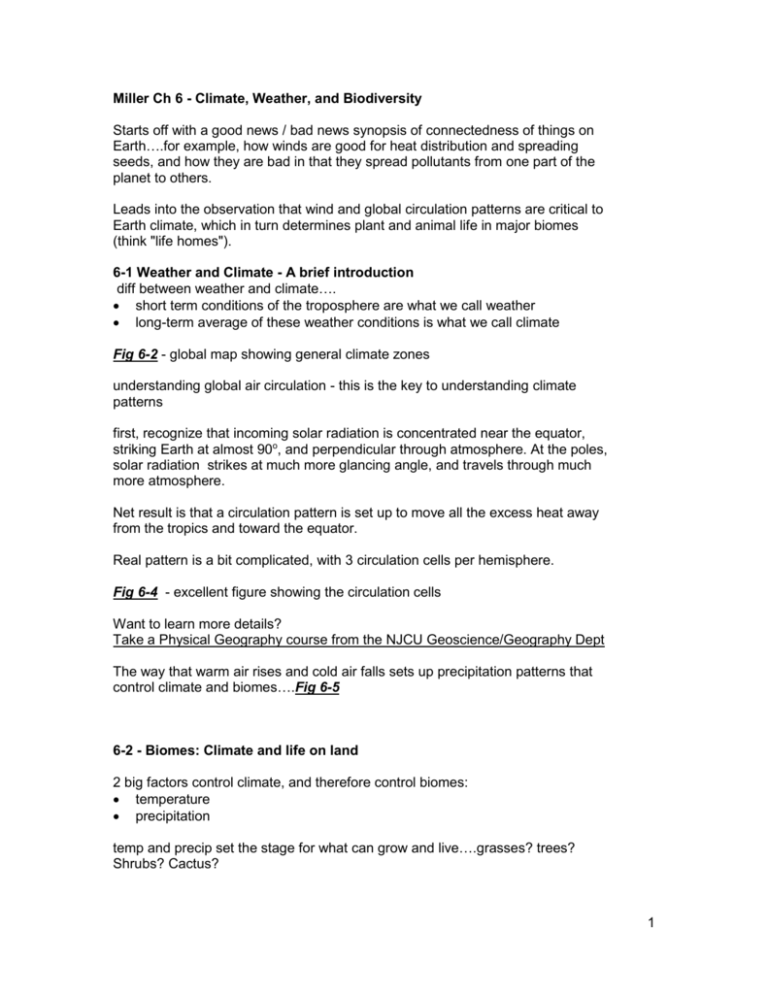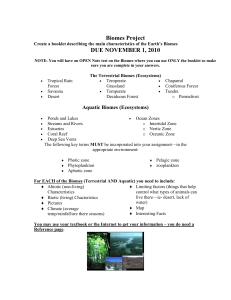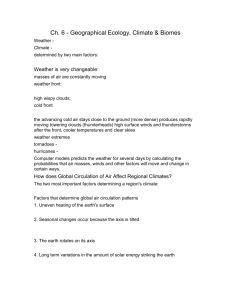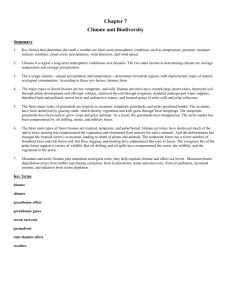Miller Ch 6 - Climate, Weather, and Biodiversity
advertisement

Miller Ch 6 - Climate, Weather, and Biodiversity Starts off with a good news / bad news synopsis of connectedness of things on Earth….for example, how winds are good for heat distribution and spreading seeds, and how they are bad in that they spread pollutants from one part of the planet to others. Leads into the observation that wind and global circulation patterns are critical to Earth climate, which in turn determines plant and animal life in major biomes (think "life homes"). 6-1 Weather and Climate - A brief introduction diff between weather and climate…. short term conditions of the troposphere are what we call weather long-term average of these weather conditions is what we call climate Fig 6-2 - global map showing general climate zones understanding global air circulation - this is the key to understanding climate patterns first, recognize that incoming solar radiation is concentrated near the equator, striking Earth at almost 90o, and perpendicular through atmosphere. At the poles, solar radiation strikes at much more glancing angle, and travels through much more atmosphere. Net result is that a circulation pattern is set up to move all the excess heat away from the tropics and toward the equator. Real pattern is a bit complicated, with 3 circulation cells per hemisphere. Fig 6-4 - excellent figure showing the circulation cells Want to learn more details? Take a Physical Geography course from the NJCU Geoscience/Geography Dept The way that warm air rises and cold air falls sets up precipitation patterns that control climate and biomes….Fig 6-5 6-2 - Biomes: Climate and life on land 2 big factors control climate, and therefore control biomes: temperature precipitation temp and precip set the stage for what can grow and live….grasses? trees? Shrubs? Cactus? 1 Fig 6-9 shows major biomes of world..they stretch laterally (East-West) and coincide with climate zones (Fig 6-2), controlled by patterns of precip set up by global circulation cells. Spend some time comparing figs 6-9 and 6-2 Note Fig 6-10 depiction of how biomes change with changing precip and temperature (temp controlled mostly by distance from equator) In general, you can classify Earth temperature into three major zones: tropical (hot) temperate (moderate) polar (cold) similarly, break precipitation into three zones exemplified by type of vegetation: forest (high precip) grasses (moderate precip) desert (low precip) these 6 factors can combine to yield Earth's biomes fig 6-11 - note interesting phenomenon associated with increasing elevation…climbing up a high mountain vertically from sea level causes you to go through the same biomes that you would travel through on a trip form the equator to either pole 6-3 desert and grassland biomes desert definition is surprisingly simple: "an area where evaporation exceeds precipitation" - this typically is about 10" of rain per year or less tropical, temperate, and cold deserts are all possible in desert biomes, 2 themes predominate: "beat the heat" "conserve water" many creative strategies used to do both these things, including staying in the shade during the day and coming out at night grassland has bit more precip than the desert, such that grasses and a few trees can grow, but it does not have enough precip to support large numbers of trees tropical, temperate, and polar grasslands exist (like deserts) one type of tropical grassland is called savanna, found in Africa 2 temperate grasslands may be prairies (US), pampas (S. Amer), veldt (Africa), steppes (Europe) polar grasslands are known as tundras 6-4 Forest and Mountain Biomes forests have moderate to high annual precipitation, which supports trees tropical, temperate, and polar (boreal) forests exist tropical rain forest is one type of tropical forest, centered near equator tree type is "broadleaf evergreen" tropical deciduous is further away from equator, little less rain temperate forests further away from equator, characterized by deciduous trees that like warm summers, can handle cold winters, and like precipitation evergreen (coniferous) boreal forest characterized by cold winters, short summers….needles are short, adapted to handle cold and dry weather 6-5 Saltwater life zones 3








